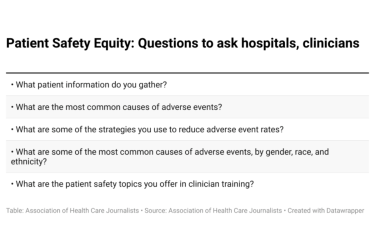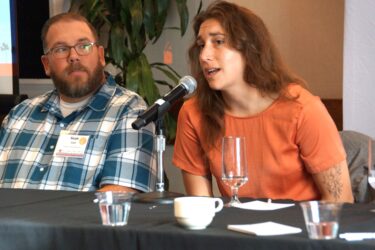
It is hard to know, amid the ongoing battle to reshape the nation’s health care system, what the future holds for dental care.
Panelists at Health Journalism 2017 tackled the unknown yet crucial territory that lies ahead in a session entitled “Oral Health Stories to Watch in 2017.” Speakers encouraged the reporters in the audience to remember to ask good questions about dental services as they cover their beats in the months ahead.
The decisions that are made, in Congress and in the states in the coming year could have a significant impact upon the financing and delivery of oral health programs, particularly for millions of children who rely upon public programs for care, observed panelist Mary Foley, who serves as executive director of the Medicare, Medicaid and CHIP Services Dental Association.
Medicaid entitles approximately 36 million poor children to dental benefits and a wide range of other services under the program’s Early and Periodic Screening Diagnostic and Treatment (EPSDT) provision. But Foley is one of many oral health advocates with concerns about what might happen to EPSDT entitlements if Republicans succeed in transforming Medicaid into a block grant program.
“So will the Medicaid entitlement program survive?” Foley asked. “Will dental services continue to be mandated for children under Medicaid? We shall see.”
Meanwhile, funding for the Children’s Health Insurance Program (CHIP), which guarantees dental benefits to 8 million children of the working poor, is set to end on Sept. 30.
“Will CHIP funding be extended beyond September 2017? How will states respond if the CHIP funds are terminated? What will happen to the existing eligible children? ” Foley asked. “Will they get folded into Medicaid? These are the questions I hope you will ask when you get back to the states you are in.”
While Foley focused on financing, panelist Jane Koppelman, research director of the Pew Charitable Trusts Dental Campaign offered perspectives on evolving dental delivery efforts in states that aim to expand access to dental services to millions of Americans who are underserved or unreached by the current system.
In one approach that is getting increasing use in a number of so-called “direct access” states, dental hygienists are being given more freedom to work in public health settings, Koppelman explained.
“What does direct access allow? It really allows hygienists to practice public health interventions and to leave the dental suite and go into schools, go into day care centers, assisted living facilities, nursing homes programs for the disabled and treat people in need that have problems getting into the dental office,” noted Koppelman. But meanwhile, in other states, laws continue to restrict the abilities of hygienists to work without a dentist present, or to care for patients who have not been examined by a dentist.
“What we are seeing now is a flurry of activity at the state level to ease these restrictions,” Koppelman said.
Telehealth technologies, already in wide use in medicine, are being adopted for dental use in some communities. In addition, an increasing number of states are looking at adopting dental therapists, Koppelman said.
The model, sometimes compared to a nurse practitioner, is faster and cheaper to train than a dentist and can be employed for roughly half the cost. Dental therapists are trained to perform a narrow range of preventive and restorative procedures, including drilling and filling teeth. They have been opposed by national and state dental organizations who say that only dentists should be allowed to perform such irreversible surgical procedures. Yet they are now working in Minnesota as well as in tribal clinics in Alaska and Washington state. A tribal pilot program has been adopted in Oregon. Since Maine and Vermont passed laws allowing the workers other states have picked up the discussion, Koppelman said. “If you are pursuing a story on oral health there is a lot of fertile ground,” she told the audience. “There is a lot of help that advocates can use and legislators can use to find out how their delivery system is working for all people and for the poor.”
With budget cuts under consideration for the National Institutes of Health, Jane Grover, director of the American Dental Association Council on Advocacy for Access and Prevention reminded listeners of the ADA’s longstanding support for funding for the NIH, and its oral health division, the National Institute of Dental and Craniofacial Research.
“We are seeking an increase in that funding. We are going to lean into the Washington administration to keep oral health as part and parcel of total health,” she said.
Among its other initiatives, the ADA is working to promote community water fluoridation efforts across the country, and is supporting emergency room diversion efforts that aim to get patients with nontraumatic dental problems such as toothaches into dental offices for appropriate care, Grover told the audience.
Currently, hundreds of thousands of Americans a year visit emergency rooms for dental problems. The visits cost the health care system roughly $1 billion and the patients seldom get the services they need in the emergency room setting. In communities such as Muskegon, Mich., promising approaches are helping reduce those costly visits, she said.
In addition, the ADA is developing its own new worker model trained to help people find care for themselves and their families in their communities, Grover said.
“We need a dental version of somebody who can not only do oral health promotion but who can navigate and understand that just handing this young mom a sheet of paper is no longer the solution in 21st century oral health services,” she explained.
The model is called a community dental health coordinator. More than 50 workers have completed training.
“By Memorial Day we will have approximately 150 individuals with certificates of completion and by the end of the year we will be over 200,” said Grover. “By the end of the year we hope to have people that are working in or who are training in over 40 states.”
Want to know more about the oral health topics discussed at Health Journalism 2017? See this tip sheet for resources.








